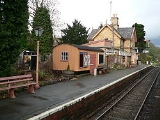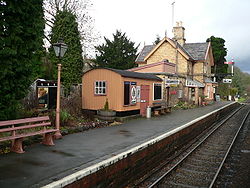
Hampton Loade railway station
Encyclopedia



Severn Valley Railway
The Severn Valley Railway is a heritage railway in Shropshire and Worcestershire, England. The line runs along the Severn Valley from Bridgnorth to Kidderminster, following the course of the River Severn for much of its route...
heritage line, close to the hamlet of Hampton on the western bank of the River Severn
River Severn
The River Severn is the longest river in Great Britain, at about , but the second longest on the British Isles, behind the River Shannon. It rises at an altitude of on Plynlimon, Ceredigion near Llanidloes, Powys, in the Cambrian Mountains of mid Wales...
; Hampton Loade itself is on the eastern bank, and may be reached by the Hampton Loade Ferry
Hampton Loade Ferry
Hampton Loade Ferry is a pedestrian cable ferry linking the villages of Hampton Loade and Hampton across the River Severn in the English county of Shropshire and providing a link to Hampton Loade village from Hampton Loade station on the heritage Severn Valley Railway, in Hampton village.The...
across the river.
History
Hampton Loade station was first opened in 1862. After opening, the station possessed only one siding on the eastern side, the passing-loop and second platform being added in 1883. Trade at Hampton Loade was usually quiet, with most business being from fishermen.Although closed by British Rail
British Rail
British Railways , which from 1965 traded as British Rail, was the operator of most of the rail transport in Great Britain between 1948 and 1997. It was formed from the nationalisation of the "Big Four" British railway companies and lasted until the gradual privatisation of British Rail, in stages...
during the implementation of the Beeching Axe
Beeching Axe
The Beeching Axe or the Beeching Cuts are informal names for the British Government's attempt in the 1960s to reduce the cost of running British Railways, the nationalised railway system in the United Kingdom. The name is that of the main author of The Reshaping of British Railways, Dr Richard...
in 1963, plans for its closure had already been made before Beeching's report was published. Following closure all signalling equipment was removed from Hampton Loade, and the signal box was almost completely demolished.
Preservation
From 1970 to 1974, Hampton Loade was the southern terminus of the SVR, just 4½ miles from BridgnorthBridgnorth railway station
Bridgnorth railway station is a station on the Severn Valley Railway heritage line, serving the Shropshire town of Bridgnorth, England. It is currently the northern terminus of the SVR, home to the main engine shed and a large gift shop amongst other facilities.-History:Bridgnorth station was not...
. Although at the time the SVR was said to go from "somewhere" to "nowhere" the terminus was a quaint and peaceful place to end services.
When preservationists first arrived at Hampton Loade from Bridgnorth, signalling was reinstated as a priority during the early days. A legacy of Hampton Loade's former guise as the SVR's southern terminus is the now rarely used down starting signal at the north end of the loop. The platforms at Hampton Loade can only accommodate four coaches at one time, as the SVR's trains are now regularly longer than this plans have been mooted to extend them.
At present, Mr.S. Dockerty is station master (appointed in 1999), he is assisted by Mr. L. Whittaker and Mr. C. Watson (both appointed in 2010). There are three Station Foremen: Mr B. Fairclough, Mr D. Shorto & Mr S. Hall, all appointed during 2010. Mr F. Hughes is the Chief Booking Clerk.
During the railway's B timetable the Severn Valley Limited dining service does not stop at the station in either direction.
Resident in the station's siding is ex-GWR Churchward third coach 2426 built in 1910. Presently being used for staff accommodation, the long term aim is to restore it to its original condition. It is the oldest carriage on the line and in continually deteriorating condition. There are possible plans for this to be replaced by Hawksworth sleeping car No. 9084 in the future, although this has come into question as that carriage is now in use at Kidderminster.
Also resident in the station siding opposite the up platform is British Railways built no. 3467; a 'fruit D' goods van designed by the GWR and built at Swindon in 1955. It is owned by the Hampton Loade Station Fund Committee and is in use as the station fund shop, known on the SVR as a 'treasure trove' for railwayana and books. It is currently painted in GWR freight grey and lettered with the words 'return to Helston'. It later had a number of W3467W and was preserved in 1973.
Signaling
Hampton Loade signal box controls three points, two distant signals, three starter signals, three home signals, and a set of catch points with related "Dummy" signal. Two of the points are located at either end of the station, controlling the exits to the loop, the third set of points controls the entrance to the siding, and are protected by the "Dummy" signal and its catch points. There are starter signals on the end of the down and up platforms, as well as a extra starter signal on the Brignorth end of the up platform which permits down trains starting at Hampton Loade to be despatched from the up platform. The home signals are located just before the loop entrance points that they protect, in the up direction a bracket carries two homes controlling entrance to the loop and main line, in the down direction a single home controls entry to the main line. In both directions working distant signals protect the homes.The Paddock Garden Railway
The station is also the home of the 32mm Paddock Garden railway, which celebrated its 21st Anniversary in 2009.Barry Railway Coach No163
Hampton Loade remains the home of Barry RailwayBarry Railway Company
The Barry Railway Company was a coal pit owner developed and owned railway company, formed to provide an alternate route for the sea export of coal mined in the South Wales valleys to the existing monopoly of the Taff Vale Railway and Cardiff Docks...
coach 163 undergoing restoration for well over a decade. An 1895 6-wheel, 5 compartment first and second class composite built at Ashburys in Manchester, it was scrapped at Swindon on Saturday 24 November 1928, (at that time the Great Western Railway would write off its account assets on Saturdays). The body went to the Clent Hills near Birmingham becoming a holiday home, where it remained until 1992. Re-wheeled onto a 4 wheel ex-Southern Railway Van C underframe on 16 August 2003 some 75 years after being scrapped, it has been in the final stages of restoration back to its opulent Barry Railway condition for several years. Standing on an isolated section of track it is not presently considered to be resident on the SVR proper.

Film and television
The station has been used as the filming location for many films and TV programmes, including The Englishman Who Went Up a Hill But Came Down a MountainThe Englishman Who Went Up a Hill But Came Down a Mountain
The Englishman Who Went Up a Hill But Came Down a Mountain is a 1995 film written by Ivor Monger and directed by Christopher Monger. It was screened in the Un Certain Regard section at the 1995 Cannes Film Festival....
, Mad Dogs, a 1970s serial and The ChuckleVision episode Oh Brother.

